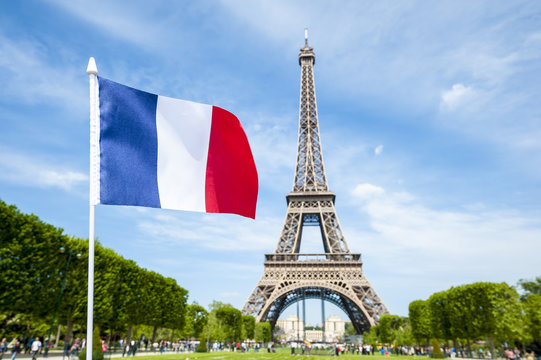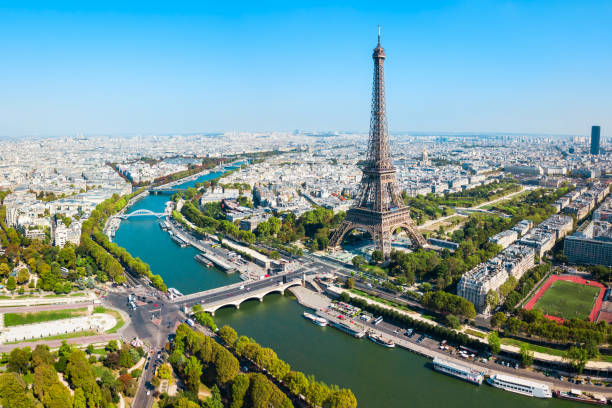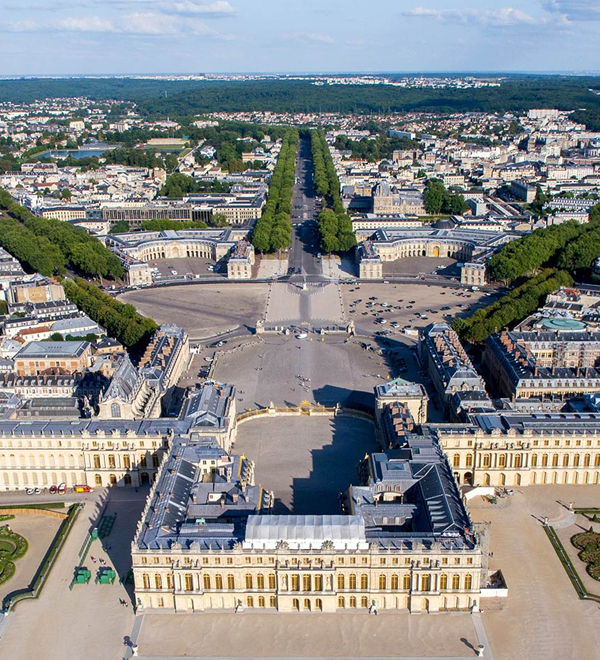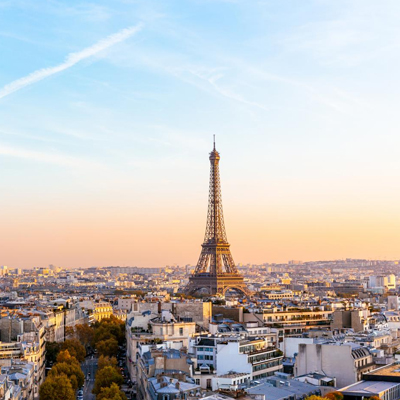Travellers fantasise about the Eiffel Tower, opulent Parisian boulevards, the sunny French Riviera, and quaint rural villages when planning a trip to France.
- Make sure you don't bring any items that are prohibited or can't pass through customs, including metal things or sharp objects, etc.
- Read and adhere to all of the France government's rules and regulations.
- Remember or write down all emergency numbers in case you need them.
- Prepare yourself with your travel documents so you can reproduce them once you arrive at the immigration desk.
- When you travel to various places in France, keep a copy of the original of your passport.
Paris: Musee de Louvre
As it befits the world's most popular museum, even the main entrance of the Musee du Louvre is an aesthetic vision. However, there isn't much time to loiter and stare up at the transparent tower. The greatest fantastical collection of artwork the world has ever seen is waiting inside, including the Code of Hammurabi, Egyptian mummies, Leonardo's Mona Lisa, and the Venus de Milo. The museum has survived France's long-term political and social shifts while preserving the breadth and beauty of the human mind under one roof, becoming a compelling representation of French delicacy and sensitivity in the process.
Eiffel Tower
The Eiffel Tower, the world's most visited paid monument, was built in 1889 by a firm owned by renowned bridge builder Gustave Eiffel to honour the centennial commemoration of the French Revolution. When you watch the tower sparkle with its millions of colourful lights at night on the Champs de Mars, you'll understand why it's such a well-liked location for marriage proposals. But regardless of the time of day, it serves as a potent emblem for the French people, serving to not only remember but also to unite and arouse strong feelings.
Versailles Palace
Louis XIV undoubtedly made the right decision in 1682 when he moved to the court of Versailles. Modern-day marvels suitable for a king include the magnificent Hall of Mirrors, the gilded royal suites, the sparkling enfilade throughout the bedrooms, and the intimacy of the artwork on the furnishings. Not to mention the classic landscape and well-maintained lawns perfectly suited to a realm of fairy tales. Together, they represent an unqualified monarchy and one of the most popular French tourist destinations.
Cathedrale de Chartres
The Cathedrale de Chartres conjures up the realisation that it represents the top echelon of French Gothic art thanks to its lovely soaring spires, ornately decorated porches, and stained-glass windows from the 12th and 13th centuries. Even though a large portion of the town of Chartres was burned down in 1134, the cathedral miraculously survived and was inscribed as a UNESCO World Heritage Site in 1979. It is unquestionably a masterpiece of French design.





 Dubai
Dubai UAE
UAE EU
EU schengen
schengen Romania
Romania Ukraine
Ukraine US
US Malta
Malta Singapore
Singapore Malaysia
Malaysia Mexico
Mexico Canada
Canada Hong Kong
Hong Kong Australia
Australia New Zealand
New Zealand South Korea
South Korea Israel
Israel Austria
Austria Belgium
Belgium The czech republic
The czech republic Denmark
Denmark Estonia
Estonia Finland
Finland United Kingdom
United Kingdom Germany
Germany Hungary
Hungary Iceland
Iceland Italy
Italy Latvia
Latvia Liechtenstein
Liechtenstein Lithuania
Lithuania Luxembourg
Luxembourg Japan
Japan Netherland
Netherland Poland
Poland Portugal
Portugal Slovakia
Slovakia Slovenia
Slovenia Spain
Spain Sweden
Sweden Switzerland
Switzerland Albania
Albania American Samoa
American Samoa Andorra
Andorra Antigua and Barbuda
Antigua and Barbuda Argentina
Argentina Bahamas
Bahamas Barbados
Barbados Bosnia and herzegovina
Bosnia and herzegovina Brazil
Brazil Brunei
Brunei Bulgaria
Bulgaria Cayman Islands
Cayman Islands Chile
Chile Colombia
Colombia El Salvador
El Salvador Faroe Islands
Faroe Islands Guadeloupe
Guadeloupe Guam
Guam Ireland
Ireland Martinique
Martinique Mayotte
Mayotte Moldova
Moldova New Caledonia
New Caledonia Puerto Rico
Puerto Rico Reunion
Reunion Egypt
Egypt Kuwait
Kuwait Oman
Oman Yemen
Yemen Saudi Arabia
Saudi Arabia Bahrain
Bahrain India
India GCC
GCC Turkey
Turkey Russia
Russia qatar
qatar Thailand
Thailand Philippines
Philippines Vietnam
Vietnam Armenia
Armenia kazakhstan
kazakhstan South Africa
South Africa Uganda
Uganda Ghana
Ghana Kenya
Kenya Sudan
Sudan Morocco
Morocco Syria
Syria Lebanon
Lebanon Iran
Iran Iraq
Iraq Azerbaijan
Azerbaijan Afghanistan
Afghanistan Algeria
Algeria Angola
Angola Anguilla
Anguilla Aruba
Aruba Bangladesh
Bangladesh Belarus
Belarus Belize
Belize Benin
Benin Bhutan
Bhutan Bolivia
Bolivia Botswana
Botswana Burkina Faso
Burkina Faso Burundi
Burundi Cambodia
Cambodia Cameroon
Cameroon Cape Verde
Cape Verde Central African public
Central African public Chad
Chad China
China Comoros
Comoros Cook Islands
Cook Islands Cuba
Cuba Democratic Republic of Congo
Democratic Republic of Congo Djibouti
Djibouti Dominica
Dominica Dominican Republic
Dominican Republic Ecuador
Ecuador Equatorial Guinea
Equatorial Guinea Ethiopia
Ethiopia Fiji
Fiji Gabon
Gabon Gambia
Gambia Georgia
Georgia Greenland
Greenland Guinea
Guinea Guinea Bissau
Guinea Bissau Haiti
Haiti Honduras
Honduras Indonesia
Indonesia Ivory Coast
Ivory Coast Jamaica
Jamaica Jordan
Jordan Kosovo
Kosovo Kyrgyzstan
Kyrgyzstan Laos
Laos Lesotho
Lesotho Liberia
Liberia Libya
Libya Macau
Macau Madagascar
Madagascar Malawi
Malawi Mali
Mali Marshall Islands
Marshall Islands Mauritania
Mauritania Mongolia
Mongolia Montenegro
Montenegro Mozambique
Mozambique Myanmar
Myanmar Namibia
Namibia Nepal
Nepal Niger
Niger Nigeria
Nigeria Norfolk Island
Norfolk Island North Korea
North Korea North Macedonia
North Macedonia Pakistan
Pakistan Palestine
Palestine Republic of the Congo
Republic of the Congo Rwanda
Rwanda Saint Helena
Saint Helena Sao Tome and Principe
Sao Tome and Principe Senegal
Senegal Serbia
Serbia Sierra Leone
Sierra Leone Solomon Islands
Solomon Islands Somalia
Somalia South Sudan
South Sudan Sri Lanka
Sri Lanka Suriname
Suriname Swaziland
Swaziland Tajikistan
Tajikistan Tanzania
Tanzania Timor-Leste (East Timor)
Timor-Leste (East Timor) Togo
Togo Tunisia
Tunisia Turkmenistan
Turkmenistan Turks and Caicos Islands
Turks and Caicos Islands Uzbekistan
Uzbekistan Vanuatu
Vanuatu Venezuela
Venezuela Zambia
Zambia Zimbabwe
Zimbabwe Costa Rica
Costa Rica Croatia
Croatia Grenada
Grenada Guatemala
Guatemala Guyana
Guyana Kiribati
Kiribati Maldives
Maldives Mauritius
Mauritius Micronesia
Micronesia Monaco
Monaco Nauru
Nauru Nicaragua
Nicaragua Palau
Palau Panama
Panama Papua New Guinea
Papua New Guinea Paraguay
Paraguay Peru
Peru Saint Kitts and Nevis
Saint Kitts and Nevis Saint Lucia
Saint Lucia Saint Vincent and the Grenadines
Saint Vincent and the Grenadines Samoa
Samoa San Marino
San Marino Seychelles
Seychelles Taiwan
Taiwan Tonga
Tonga Trinidad and Tobago
Trinidad and Tobago Tuvalu
Tuvalu Uruguay
Uruguay Vatican City
Vatican City cyprus
cyprus Greece
Greece









